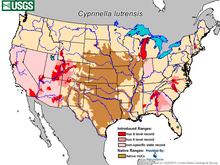- Red Shiner
-
Red Shiner Red Shiner, Cyprinella lutrensis Scientific classification Kingdom: Animalia Phylum: Chordata Class: Actinopterygii Order: Cypriniformes Family: Cyprinidae Genus: Cyprinella Species: C. lutrensis Binomial name Cyprinella lutrensis
Baird & Girard, 1853Synonyms Red-horse Minnow and Notropis lutrensis
The Red Shiner (Cyprinella lutrensis) is a species of ray-finned fish in the Cyprinidae family. They are deep-bodied and laterally compressed[1] and can grow to about three inches in length. For most of the year both males and females have silver sides and whitish abdomens. Males in breeding coloration, on the other hand, have iridescent pink-purple-blue sides and a red crown and fins (except the dorsal fin which remains dark).[2]
Contents
Biology
Red shiners can live up to three years. They are omnivorous since they eat both aquatic and terrestrial invertebrates as well as algae.[3] Red shiners have also been known to eat the eggs and larvae of native fish found in locations into which the red shiner has been introduced.[4]
Reproduction
The spawning season for red shiners is generally from mid-April through September.[1] As well as spawning in crevices like other members of the genus Cyprinella, red shiners both broadcast their eggs and attach them to rocks and vegetation.[5] Females can release up to 16 batches per day with up to 71 eggs per batch. The average clutch size, however, is 585 eggs and they may have anywhere from 5 to 19 clutches in one reproductive season.[6] Red shiners are capable of generating viable hybrid offspring with closely related species such as the blue shiner and the blacktailed shiner.[5]
Habitat
Red shiners are found naturally in a variety of aquatic habitats, including backwaters, creek mouths, streams containing sand and silt substrates, riffles, and pools.[1] [7] They are tolerant of areas of frequent high turbidity and siltation,[8] but they tend to avoid waters with high acidity.[9] Red shiner are habitat generalists in that they are adapted to favor a wide range of environmental conditions that most other fish species cannot tolerate. These include habitats that are degraded due to human disturbance, and those with poor water quality (such as polluted waterways), natural physiochemical extremes, and seasonally intermittent flows.[5]
Range
The red shiner is naturally found in the Mississippi River basin from southern Wisconsin and eastern Indiana to South Dakota and Wyoming and south to Louisiana. It is also found as an introduced species in Arizona, Alabama, California, Colorado, Illinois, Georgia, Nebraska, the Carolinas, Wyoming, Massachusetts, Utah, Virginia, Nevada, and New Mexico.[10]
Invasiveness
The red shiner is a common bait fish, and it is believed that the emptying of bait buckets containing them is the main cause of introduction of this species into new areas. It is also commonly used as an aquarium fish.[10] It has become a species of special concern in the United States as it has been implicated in the decline of native fish populations in the areas into which it has been introduced. As previously mentioned, red shiners have been known to eat the eggs of native fish and in doing so hinder the growth of those populations.[4] They are also adapted to thrive in a variety of environments, and as generalists, may be better able to persist in disturbed habitats than native species of those areas. Red shiners are capable of hybridizing with the blacktail shiner (Cyprinella venusta stigmatura), a native species found in the Coosa River, which serves to dilute the gene pool of this species.[5]
References
- ^ a b c Farringer R.T., III, A.A. Echelle, and S.F. Lehtinen. 1979. Reproductive cycle of the red shiner, Notropis lutrensis, in central Texas and south central Oklahoma. Transactions of the American Fisheries Society, 108, 271-276.
- ^ Mayden, R.L. 1989. Phylogenetic studies of North American minnows, with emphasis on the genus Cyprinella (Teleostei: Cypriniformes). The University of Kansas Museum of Natural History, Miscellaneous Publication, 80, 1-189.
- ^ Goldstein, R.M., & Simon, T.P. (1999). Toward a united definition of guild structure for feeding ecology of North American freshwater fishes, in T.P. Simon, editor. Assessing the sustainability and biological integrity of water resources using fish communities. CRC Press, Boca Raton, Florida, 123-202
- ^ a b Ruppert, J.B., Muth, R.T., Nesler, T.P. (1993). Predation on Fish Larvae by Adult Red Shiner, Yampa and Green Rivers, Colorado. The Southwestern Naturalist, 38(4), 397-399.
- ^ a b c d Burkhead, N. M., & Huge, D. H. (2002). The Case of the Red Shiner:What Happens When a Fish Goes Bad? Retrieved October 13, 2010, from USGS: http://fl.biology.usgs.gov/Southeastern_Aquatic_Fauna/Freshwater_Fishes/Shiner_Research/shiner_research.html
- ^ Gale, W.F. (1986). Indeterminate fecundity and spawning behavior of captive red shiners - fractions, crevice spawners. Transactions of the American Fisheries Society, 115, 429-437.
- ^ Hubbs, C., Kuehne, R.A., Ball, J.C. (1953). The fishes of the upper Guadalupe River. Texas Journal of Science, 5(2), 216-244.
- ^ Cross, F.B. (1967). Handbook of fishes of Kansas. University of Kansas Museum of Natural History, Lawrence, 357.
- ^ Matthews, W.J., & Hill, L.G. (1979). Influence of physico-chemical factors on habitat selection by red shiners, Notropis lutrensis. Copeia, 70-81.
- ^ a b Nico, L., & Fuller, P. (2010). Cyprinella lutrensis. USGS Nonindigenous Aquatic Species Database, Gainesville, FL.
Categories:
Wikimedia Foundation. 2010.


